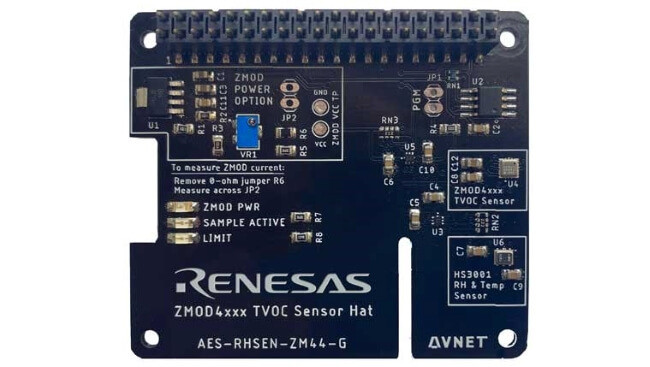Avnet Raspberry Pi Air Quality HAT Released
20-08-2020 | By Robin Mitchell
Recently, Avnet released a Raspberry HAT for recording indoor air quality. What does air quality refer to, what are HATs, and what projects can this HAT help to build?
What is Air Quality?
Air quality refers to the purity of air, and air purity relates to the number of pollutants in the air. If human activities are removed from the equation, pure air would be a mix of 78% nitrogen, 21% oxygen, and 1% trace gasses including CO2 and Argon. Pollutants in the atmosphere include additional CO2 (as a result of fossil fuel burning), volatile compounds (methane, sulphur dioxide), and particulates (soot from chimneys and vehicles). Generally speaking, pollutants are not wanted, and their reduction is essential. But areas indoors can be more at risk as pollutants can build-up due to a lack of ventilation. Of course, there are times when keeping the outside air outside is more preferable (during times of smog), and thus getting the balance right is important.
What is a Pi HAT?
A Pi HAT stands for hardware Added on Top, and these can be thought of as Arduino shields designed for use on the Raspberry Pi range of computers. These HATs can provide a Raspberry Pi with a variety of additional hardware and features including motor controllers, power controllers, radio communications, sensors, and displays. While discrete circuitry can be constructed, HATs are far more convenient for prototyping. HATs make use of the GPIO 40-pin header connection on the top left of the Raspberry Pi, and HATs are often compatible with all Raspberry Pis.
introduces the Avnet indoor air quality Pi HAT for the Raspberry Pi
Avnet, who is a significant leader in semiconductor devices and hardware, have recently announced the release of their indoor air quality Pi HAT. The HAT utilises the ZMOD4410 indoor air quality sensor produced by Renesas but also contains an HS3001 humidity and temperature sensor. The ZMOD4410 utilises a metal oxide chemiresistor and can be used to detect volatile organic compounds as well as estimate the CO2 levels in the surrounding air. The sensor can be made to produce a control signal upon specific actions (such as detection level) and has a 16-bit maximum ADC resolution. The sensor communicates over I2C, and the sensor on the HAT is both electrically and chemically tested in a laboratory with calibration data stored in the sensor itself. Outfitted with VOC, temperature, and humidity sensors, the Avnet Raspberry Pi indoor air quality HAT is well-equipped for environmental sensing and monitoring.

Credit: Avnet
Possible Applications: Home automation, air quality control, and environmental sensing
The use of an indoor air quality sensor allows for a wide range of potential applications, including smart home automation, air quality control, and environmental monitoring. Home automation would greatly benefit from the HAT as it would allow for windows, AC units, and vents to be fully automated. Such automation would enable a house to react dynamically to the environment both inside and out, and thus make the best decision as to whether to allow the building to breathe or not. Its ability to detect volatile compounds can also be useful for monitoring potential chemical or gas leaks, and alert users upon detection. The same would also apply to fire suppression; the detection of excess CO2 could alert users to a possible fire. But homes are not the only application that would benefit from air quality monitoring; medical fields could greatly benefit from carefully monitoring their air for conditions that may be detrimental to those with breathing difficulties. Events such as COVID-19 may benefit by mounting the sensors in ICUs to detect animalities in the air that could contribute to worsening conditions in patients.
While the sensor is designed for indoor use, it can still be used to provide critical environmental data. Strategic placing of the sensor across a building near entrances would give insight into the quality of air outside. It could even be mounted in special enclosures for monitoring outside conditions as an easy to use environmental data logger.
Read More

